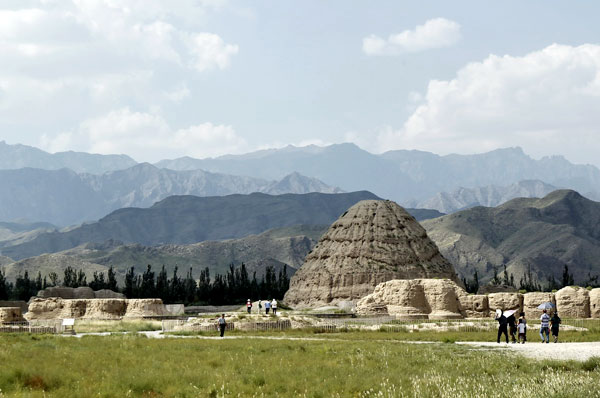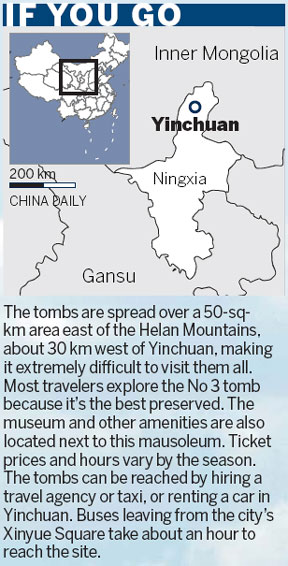A lost people
Updated: 2013-01-24 10:37
By Erik Nilsson (China Daily)
|
|||||||||
 |
|
Western Xia Tombs, acclaimed as "Oriental Pyramids", are the prime attraction in Yinchuan, Ningxia Hui autonomous region. Liu Xuezhong / For China Daily |
Genghis Khan obliterated most of the Dangxiang ethnicity for refusing to join his invasion of the Khwarezmian Empire. Now archaeologists are trying to dig deeper to find out more about the race. Erik Nilsson joins the search.
Archaeologists are digging for - and unearthing - answers about the Dangxiang ethnicity, whose saga was buried with them when they virtually vanished in a mass slaughter.
They're mining the Western Xia (1038-1227) Tombs for narrative nuggets to resurrect the stories of the people who perished in Genghis Khan's final battle.
Little is known about the Dang-xiang, also called the Tangut. Most of what has been determined has been gleaned from the Western Xia's nine imperial mausoleums and 250 royal family tombs that stud the desert outside of Yin-chuan, capital of today's Ningxia Hui autonomous region.
Genghis Khan essentially obli-terated the Dangxiang for refusing to join his invasion of the Khwarezmian Empire.
So these tombs' ruins commemorate not only the ethnicity's rulers but also their tribes' last stand.
But only one of these structures - the No 3 mausoleum, believed to belong to the Western Xia's first emperor - has been fully excavated.
Like Dangxiang history, the tombs remain relatively obscure in public consciousness.
They're skeletons of their previous physiques, stripped by decay of the tiled flesh that made them the first fusion of traditional ethnic Han mausoleum design and Tibetan Buddhist temple architecture.
The tombs may have served as a metaphor for the ethnic group's exterminated tribes. Most of the sepulchers' structures have worn away, like the saga of the people their inhabitants ruled.
The sands of time have ground the structures from octagonal towers into conical earthen mounds - nubs of their former selves. They look like huge loess dollops, or colossal termite mounds, although their initial splendor is believed to have rivaled that of Beijing's iconic Ming Tombs.
But the burial chambers' current shapes have endowed them with marketing magnetism. The "Oriental Pyramids" are by far the city's principal attraction.
Their contours resemble the Helan Mountains that serve as their backdrop. Helan's peaks are crowned by the Great Wall's terminus, constructed to keep out the Mongolian invaders, who ultimately breached the bulwark to extinguish the Western Xia.
But while most tribes were wiped out, some Dangxiang outlasted their empire. One excavator is believed to be the last emperor's 23rd-generation descendant.
The main tombs were discovered during the construction of a military air base in 1972. The unearthing of ancient bricks and pottery offered the first hints that the soil encrusted something special.
That led the military to bring in archaeologists, who discovered coins, sculptures and tablets engraved with the Western Xia's unique characters.
This enticed them to dig deeper, whereupon they exposed the mausoleums.
Only nine of the empire's 12 kings' final resting places have been found.

 'Taken 2' grabs movie box office crown
'Taken 2' grabs movie box office crown
 Rihanna's 'Diamonds' tops UK pop chart
Rihanna's 'Diamonds' tops UK pop chart
 Fans get look at vintage Rolling Stones
Fans get look at vintage Rolling Stones
 Celebrities attend Power of Women event
Celebrities attend Power of Women event
 Ang Lee breaks 'every rule' to make unlikely new Life of Pi film
Ang Lee breaks 'every rule' to make unlikely new Life of Pi film
 Rihanna almost thrown out of nightclub
Rihanna almost thrown out of nightclub
 'Dark Knight' wins weekend box office
'Dark Knight' wins weekend box office
 'Total Recall' stars gather in Beverly Hills
'Total Recall' stars gather in Beverly Hills
Most Viewed
Editor's Picks

|

|

|

|

|

|
Today's Top News
Boston bombing suspect reported cornered on boat
7.0-magnitude quake hits Sichuan
Cross-talk artist helps to spread the word
'Green' awareness levels drop in Beijing
Palace Museum spruces up
First couple on Time's list of most influential
H7N9 flu transmission studied
Trading channels 'need to broaden'
US Weekly

|

|









